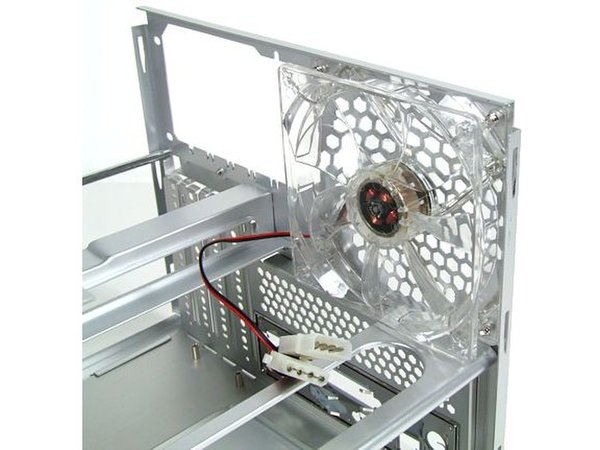Once again something about body sound
The volume information in the fan data sheets is almost always given in dB(A). This means that a frequency assessment adapted to the human ear, the so-called A-curve, has been carried out, and this unfortunately, as mentioned above, refers exclusively to the resulting airborne sound. Unfortunately, the value for airborne sound alone is hardly suitable for estimating the noise in a device. In addition, a so-called body sound is produced. So what do you have to mean by that?
These are predominantly low-frequency vibrations, which are caused by the motor and through the bearing and are then transmitted directly to the housing by the fan via the rigid and tightly screwed frame. The large-area housing wall then radiates these annoying vibrations like a loudspeaker membrane as airborne sound, with better and stiff housings less susceptible. In addition, the housing body may act. even like a resonant body, which reinforces the impression.

What we see in the picture above is the nightmare of all self-builders. A rigidly screwed fan on a thin aluminum frame. This gives music to the ears and whistles to the core!
Properly decouple the fan
First of all, a bad news: pure decoupling frames only benefit one, namely the manufacturer, because a large part of the vibrations will pass on via the screws. Better than screws are so-called soft slics, bolts or screws made of rubber or silicone. If you combine them together, e.g. with a thin 12/13cm flat seal from the sanitary or mechanical parts trade, then the decoupling is really perfect. As a substitute for 92 cm fans, grandma’s insertion rings, which can be firmly glued into the housing by means of acrylic adhesive, also go. Bolts are therefore preferable to normal screws in any case.
 Bolts in soft rubber Bolts in soft rubber |
 Screws from the accessories trade Screws from the accessories trade |
Fan with soft rubber frame
Companies such as Noiseblocker, Noctua and others now offer fans with soft fan frames made of hard rubber or at least used rubber applications that can be screwed firmly to the housing. The whole frame already acts as decoupling and the Slics bwz. Bolts can be omitted. Decoupling at zero cost. Well, the fan is not free, but also not for nothing. Only cheap.
- 1 - Einführung und Übersicht
- 2 - Unter- oder Überdruck? Wir wägen ab!
- 3 - Netzteilpositionierung: Oben oder unten?
- 4 - Airflow: Towerkühler senkrecht montieren
- 5 - Airflow: Towerkühler waagerecht montieren
- 6 - Airflow: Beliebte Montagefehler
- 7 - Airflow: Downblower-Besonderheiten
- 8 - Airflow: Festplattenkühlung
- 9 - Airflow: Grafikkarten richtig belüften
- 10 - Gehäuselüfter: Wissenswerte Grundlagen
- 11 - Unangenehm: Körperschall und Resonanzen
- 12 - Lüftersteuerung, Zusammenfassung und Fazit


































76 Antworten
Kommentar
Lade neue Kommentare
Urgestein
Veteran
Urgestein
Urgestein
Urgestein
Urgestein
Veteran
Veteran
Veteran
Urgestein
Veteran
Veteran
Urgestein
Mitglied
Urgestein
Veteran
Mitglied
Veteran
Veteran
Alle Kommentare lesen unter igor´sLAB Community →